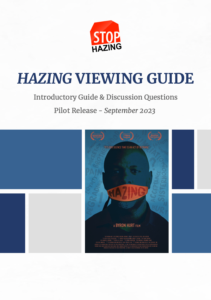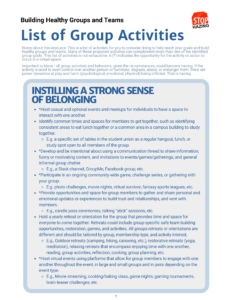Research-to-Practice Series: Part 2

Building on Part 1, Part 2 of our ongoing Research-to-Practice Series summarizes peer-reviewed research from StopHazing’s research team and offers practical resources to help you prevent hazing in your community. At StopHazing, we believe in turning research into actionable strategies, and this edition highlights tools that can make a real difference in your efforts.
This time, we’re focusing on a key intervention, We Don’t Haze (a film and training), and exploring the critical intersections of hazing and identity, including race and gender. Whether you’re an educator, student leader, administrator, or parent, these insights and tools are designed to help you take effective steps in combating hazing.
Key Research and Resources Featured:
As a reminder and building on Part 1 of the series, this blog content is structured as follows:
- The research publication citations
- Resources directly linked to the research
- How the resources and research can support your practice
We Don’t Haze: A Rigorously Evaluated Prevention Tool
This section dives into the effectiveness of We Don’t Haze, a video-based prevention intervention evaluated through extensive research. It’s an excellent resource for anyone looking to make an impact in both high school and college settings.
Featured Studies:
- Kerschner, D. & Allan, E. J. (2024). Testing the effectiveness of a video-based hazing prevention training for college students. Journal of Interpersonal Violence.
- Allan, E. J., Hakkola, L.H., & Kerschner, D. (2020). High school hazing prevention and gender. Journal of School Counseling.
- Hakkola, L., Allan, E. J., & Kerschner, D. (2019). Applying utilization-focused evaluation to high school hazing prevention: A pilot intervention. Evaluation and Program Planning. https://doi.org/10.1016/j.evalprogplan.2019.05.005


Companion Resources:

- We Don’t Haze Documentary
- We Don’t Haze Companion Guide
These resources provide concrete ways to engage students and foster healthy group dynamics without hazing. Use these tools to change attitudes and promote a culture of respect and safety in your community.
Hazing & Identity: Exploring the Intersection of Hazing and Identity
This edition also takes a deeper look at how hazing intersects with race, gender, and identity. Our research highlights how hazing can exacerbate systemic issues like white supremacy, and how these factors influence the experience of hazing on campus.
Featured Studies:
- Gillon, K. E., Allan, E. J., Beatty, C., Salinas, C., & Kerschner, D. (2024). Troubling rigor: Exploring intersections of campus hazing and white supremacy. Innovative Higher Education. doi.org/10.1007/s10755-024-09737-1
- Allan, E. J., Gillon, K., Beatty, C., Salinas, C., & Kerschner, D. (2024). Unsettling tradition: Exploring intersections of campus hazing and white supremacy. International Journal of Qualitative Studies in Education,1-20. https://doi.org/10.1080/09518398.2024.2318275
- Allan, E. J. & Nuwer, H. (2023). Hazing in fraternities and sororities. In Bogle, K. A. (Ed.). Gender-based crime: Learning through experts and cases. Series on Family and Gender-based Violence (pp. 89-106). San Diego, CA: Cognella
- Allan, E. J. & Kinney, M. (2018). Hazing and gender: Lenses for prevention. In Nuwer, H. (Ed.). Destroying Young Lives: Hazing in Schools and the Military (pp. 100-115). Bloomington, IN: Indiana University Press.



Companion Resources:
- HAZING Documentary & Viewing Guide
- Building Healthy Groups & Teams Resources
- 10 Signs of Healthy & Unhealthy Groups Toolkit



These resources help bridge research findings with real-world practices, providing guidance for supporting students across various identity groups and fostering healthier team dynamics.
How to Use These Resources and Research:
- Learn about the intersections of hazing and white supremacy to better support students and their lived experiences
- Connect research findings with student experiences through the documentary HAZING and companion resources
- Discover how to help students foster healthy team dynamics free from hazing
- Connect the intersections of hazing and gender to best support students and implement effective programming
- Utilize resources for best supporting high school and college students
- Understand gender-based crimes and their intersections with hazing
How to Apply These Insights
- Use the documentary: Show “We Don’t Haze” to shift attitudes toward hazing among students and the community.
- Apply the research: Incorporate findings on race and gender into your hazing prevention strategies.
- Strengthen your community: Utilize the “Building Healthy Groups & Teams” toolkit to foster supportive, hazing-free environments in both high school and college settings.
Guidance for Accessing Research Publications
View this document for guidance on how to access the peer-reviewed research publications and academic journals mentioned.
What’s Next? Stay Tuned for Part 3!
In the final part of our series, we’ll dive into StopHazing’s research on hazing in military, athletics, and intersections with Black Greek Letter Organizations and sexual violence prevention. These insights will further equip you with the knowledge and tools needed to keep pushing forward in our shared mission of preventing hazing.
Thank you for your continued commitment to hazing prevention. Together, we’re building safer, more inclusive communities.
Questions about the research or resources? Reach out to Meredith Stewart, meredith@stophazing.org to connect.
